SOLD ITEMS
Showing 10981–11040 of 14048 results
-
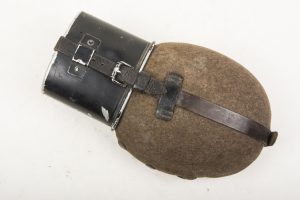
Matching M31 canteen marked MKK 37
A very nice matching M31 canteen marked MKK 37 which is a rare maker to find!
-
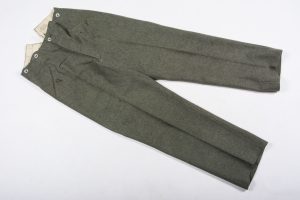
Heer/Waffen-SS M40 trousers
Very nice Heer/Waffen-SS M40 trousers in good, lightly worn condition. The garment has one period repair to the back seat. The garment retains most if not all of its period sewn buttons and would be very nice to complete a mannequin with. The back of the trousers have some mothing, nothing on the front. This is a perfect pair for a mannequin!
-

M36 tunic hook support straps
A nice set of two M36 uniform belt support hook straps. The ends have been made longer at some point. Most probably for a tall soldier! These where found together and are virtually always missing from the garment.
-
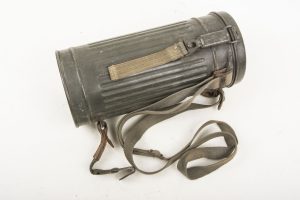
M38 gasmask in good complete condition
Nice complete M38 gasmask canister in very good condition with most of the original factory paint. The straps still have the leather reinforcements. Nice complete gasmasks are becoming hard to find!
-
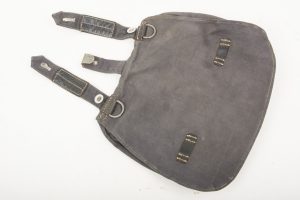
Early pattern Luftwaffe breadbag
Nice early pattern Luftwaffe breadbag.
-
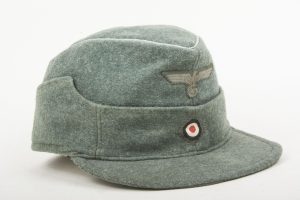
Heer officers field cap manufactured from Dutch sidecap
Unique Pre war Dutch sidecap that was converted during the war to a German army officers field cap. The cap is nicely marked J.P. Mol Breda (the Netherlands) and is a good size 57. Scarce and unique piece that I’ve never encountered before!
-
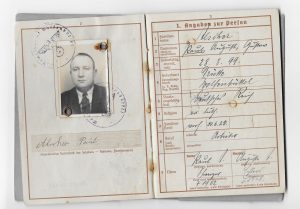
Wehrpass Art Regt 67, Holland, Belgium, France
Nice original Wehrpass to a artillery man in Artillerie Regiment 67. Interesting unit that saw lots of action during the Westfeldzug in 1940; Holland, Belgium and France. A great source for further research!
-

Brown luftwaffe pattern mapcase
Nice original Luftwaffe pattern brown leather mapcase.
-

Luftwaffe breast eagle
Nice original wool backed Luftwaffe breast eagle.
-
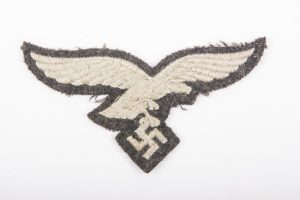
Luftwaffe breast eagle
Nice original wool backed Luftwaffe breast eagle.
-
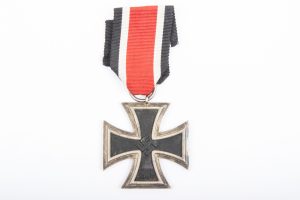
Iron cross second class marked 65
Very nice original iron cross second class marked 65 indicating production by Klein und Quenzer.
-
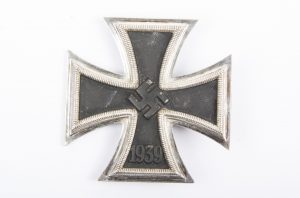
Iron cross first class marked 65
Very nice original iron cross first class marked 65 indicating production by Klein und Quenzer.
-
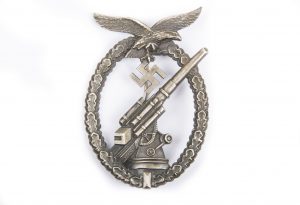
Luftwaffe Flak badge in tombak
Very nice early tombak or Buntmetall Flakkampfabzeichen. Typical early heavy and high quality construction with a textbook ball-hinge pin.
-
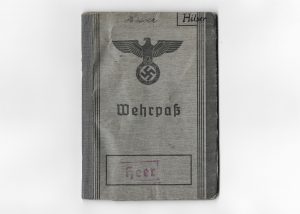
Wehrpass to Paul Hilser IR 75 France, Denmark, Russia, Demjansk
Nice Wehrpass to Paul Hilser, Infanterie Regiment 75. Served the complete 1940 campaign of France later to continue into the east in Denmark, Russia, and the battle for Demjansk. He was awarded the Verwundeten Abzeichen im Schwarz 4.10.42. Hilser was killed in action 10.07.1944 in Lesniaki, Ukraine.
-
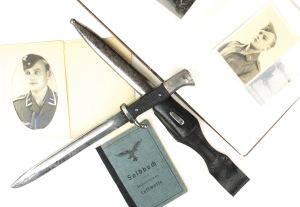
Soldbuch grouping Flak Regiment Hermann Goering – Normandy, Falaise, Caen
This is a stunning Soldbuch grouping from 4. Flakersatzabteilung 6. member Heinrich Janssen (born in Düsseldorf), who was among other units in 1942 part of Flak-Regiment Hermann Göring! The Soldbuch grouping also comes with his photo album and dress bayonet.
Unteroffizier Janssen served with several interesting Flak units during the war such as Flak-Regiment Hermann Göring in 1942. The last of those was the II./Flak Regiment 22 which was later renamed II./Flak-Sturm-Regiment 22(mot). He served with the 8. Batterie, which was equipped with 8,8cm Flak guns and was fully motorized. This regiment was subordinate to the Flak-Sturm-Regiment 3 which was part of the III Flakkorps under the command of Pickert. It was deployed between Amiens and Arras in France before the D-Day landings in Normandy. After the landings the unit was sent to Normandy in a hurry arriving a few days later. They where deployed between the Orne and Vire rivers, supporting the ground units and engaging the Allied airforce. And at the end of the Normandy fightings the III Flakkorps provided a significant role in covering the withdrawal of the German forces in the Falaise gap. The unit later retreated to northern France. Unteroffizier Janssen must have seen quite some action in Normandy. The Soldbuch lists the following awards; Verwundetenabzeichenn in Schwarz on 12.9.44 and Eisernez Kreuz 1 and 2 14.9.44. He was severely wounded as he was hospitalized in Hersfeld which is also photographed in the album. A great Soldbuch group to a Normandy veteran who for sure saw heavy action!
The grouping comes with a nice album with 87 photographs with many private shots of 8,8cm flak guns and the famous Sdkfz. 9 Famo halftrack. A great group that would be a great base for further research!
-
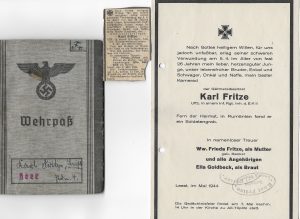
Wehrpass grouping IR 337, Holland Peel-Maas Stellung, Antwerp, Flandern, Gent, Dunkirk, Krim
Nice Wehrpass grouping to Karl Fritze, Infanterie Regiment 337. Fritze was drafted in 1939 and entered the war on 10th of May 1940.
The Wehrpass indicates Fritze took part in the following battles;
1940 – Holland
Attack of the Peel – Maas Stellung.
1940 – Belgium
Attack of Festung Antwerpen
Crossing of the Schelde river
Battles for Ost Flandern
Breaktrough at Gent fortifications
Attack at the Neuzen-Gent Kanal
1940 – France
Battle for Dunkirk
French coastal defense at the Atlantik
1942 – Ukraine
Battle and defense at the KrimFritze was promoted to Obergefreiter 1.11.42 and Unteroffizier 1.2.43. He died 5.4.44 near Odessa on a ship. He was awarded the EK2 and KVK2 but its not mentioned in the Wehrpass itself. A great Wehrpass with a impressive battle list.
-

Named US M1 helmet liner 29th Infantry Division
Superb original unit ID’ed M1 helmet liner to a member of the 29th Infantry division. Nicely named Woods on the back. The liner bears the divisional insignia of the famous 29th Infantry division to the front. Inside the liner the partial ASN 1688 can be read. The toal is 33531688 from Private James K. Page who enlisted in Virginia and served in the 29th Infantry Division. Exceptional to find a original 29th ID helmet with the insignia to the front. The liner is in obviously combat worn and as found condition.
-

Hollow early Infantry assault badge Juncker in Tombak
A very nice and early original Infanterie Sturmabzeichen by Juncker. Very nice hollow and early Tombak (!) example in exceptional condition!
-

Panzer assault badge in bronze by Wurster in tombak
Lovely early example of a minty Würster manufactured Panzerkampfabzeichen. Superb example with textbook pin setup and a full remaining finish!
-
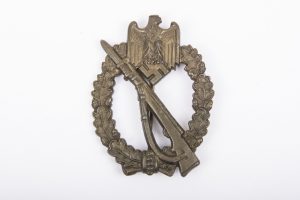
Infantry assault badge in bronze marked MK
Stunning mint original infantry assault badge or Infanterie Sturmabzeichen in bronze marked MK.
-
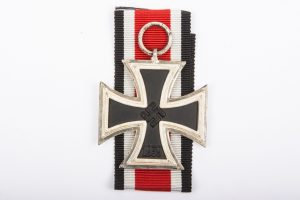
Mint iron cross second class
Nice near mint Iron cross second class or Eisernes Kreuz 2. Klasse. The cross remains most of its original finish, paint and ribbon. Very nice textbook example.
-
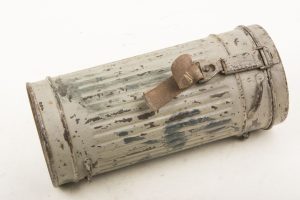
Two tone camouflaged gasmask canister
Nice original two tone brush painted camouflage gasmask canister in very good condition. The canister is a very nice example of a lightgrey with blue brush painted camouflage pattern with 90% of the original camouflage paint remaining. Most probably a Coastal Artillery or Navy gasmask canister!
-
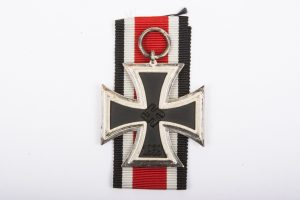
Mint iron cross second class
Nice near mint Iron cross second class or Eisernes Kreuz 2. Klasse. The cross remains most of its original finish, paint and ribbon. Very nice textbook example.
-
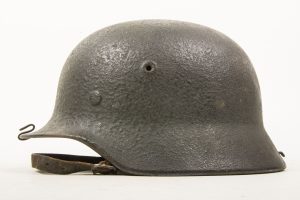
Q64 M40 Rautarn camouflage helmet with netting hooks
Stunning example of a mid to late war Q64 marked Heer/Waffen-SS camouflage helmet indicating production by Quist. The helmet is externally completely covered in thick concrete paint. The helmet has a set of period applied metal wire loops for the application of a helmet net. The named leather liner and chinstrap are original to the helmet. The helmet is a killer example of a wartime camouflage helmet with thick concrete paint completely embedding the liner pins. This would be a impeccable helmet for any helmet collector, impossible to upgrade and textbook Rautarn and Tarnnetz camouflage helmet!
-
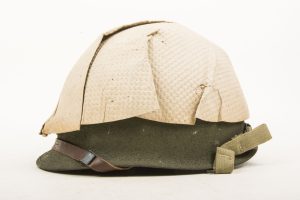
Stone mint US M1 helmet with Westlinghouse liner
Stone mint US M1 front seam helmet with Westinghouse liner and original factory paper wrap. Impossible to upgrade and a genuine must have for any US M1 helmet collector. The helmet retains its original factory stacking paper that I’ve never seen before. For sure the best M1 helmet I’ve had to offer and is arguably the best condition M1 helmet on the market today.
-
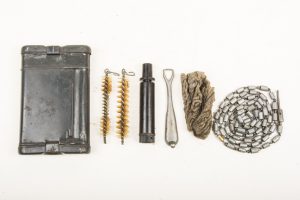
RG34 marked AB41
Nice matching RG34 marked ab41 indicating production by Mundlos Aktien Gesellschaft. Hard to find a RG34 with all original components and in matching condition!
-
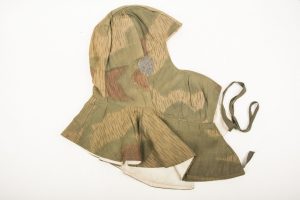
Reversible winter hood in Sumpftarn camouflage
Nice original Kopfhaube as issued with the reversible Sumpftarn winter parka in mint condition.
-
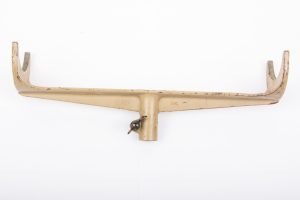
Tan painted Lagergabel for Entfernungsmesser marked fwq
Very nice original Lagergabel marked fwq indicating production by Saalfelder Apparatebau Gesellschaft m.b.H., Saalfeld. Very hard to find in the original tan colour and virtually always missing in the large transport cases!
-
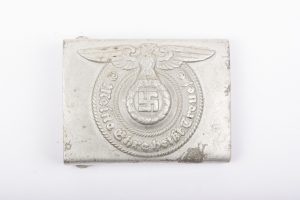
Aluminum Waffen-SS belt buckle marked RZM 36/40 ᛋᛋ
A scarce buckle! The aluminum buckle is marked RZM 36/40 ᛋᛋ indicating production by Overhoff in 1940. These buckles in aluminum where only produced for one or two months when the order came to halt the production in aluminum and switch to steel early in 1940. Rare and hard to find buckle and a essential piece for the specialized buckle collector!
-

Minty Luftschutz Gladiator helmet
A nice original Luftschutz gladiator type helmet in good condition. The original decal still retains up to 90%.
-
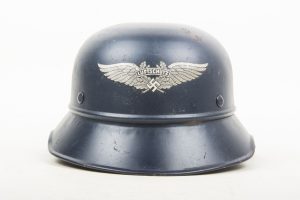
Luftschutz Gladiator helmet size 58
A nice original Luftschutz gladiator type helmet in good condition. The original decal still retains up to 90%.
-
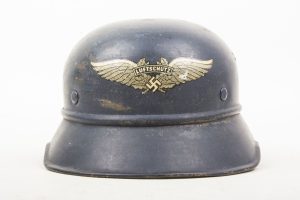
Luftschutz Gladiator helmet size 55
Sale!A nice original Luftschutz gladiator type helmet in good condition. The original decal still retains up to 90%.
-
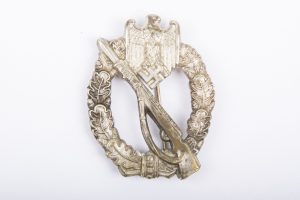
Hollow early Infantry assault badge Schauerte und Höhfeld in Tombak!
A very nice and early original Infanterie Sturmabzeichen by Schauerte und Höhfeld. Very nice hollow and early Tombak (!) example!
-
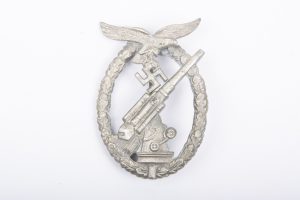
Luftwaffe Flak badge üü Wiedmann
Very nice original Luftwaffe Flakkampfabzeichen marked üü indicating production by Wiedmann. Textbook ‘lilly hinge pin’ construction.
-

Iron cross second class
Nice original Iron cross second class or Eisernes Kreuz 2. Klasse. The cross remains most of its original finish, paint and ribbon. Very nice textbook example.
-

Mint Luftwaffe tropical pith helmet
Rare original Luftwaffe tropical pith helmet in very good, near mint condition. The helmet is complete with both its originally attached insignia and chinstrap.
-

German anti tank gun sight marked Z.F. 3×8 DZL
Very nice original German anti tank gun sight marked Z.F. 3×8 DZL indicating production by Optische Anstalt Oigee G.m.b.H.,, Berlin-Schoeneberg. The sight is in good condition with working optics. If you really need to use them to stop hordes of T34’s I would suggest prior cleaning otherwise a very nice display piece!
-

Exceptional pre war k98 bayonet marked S/175 K indicating 1934 production
One of the earliest K98 bayonets I’ve encountered. A stunning matching k98 bayonet marked S/175 K indicating production by F. W. Holler in 1934. The bayonet is in stunning condition, with 99% of its original blueing intact. This is a very rare, and exceptional bayonet. Very hard to upgrade!
-
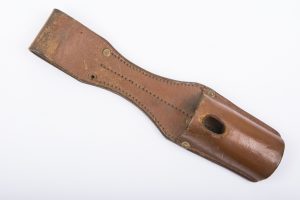
Lightbrown leather bayonet frog J. De Valk, Amsterdam
Very nice original leather bayonet frog made in Amsterdam, the Netherlands on behalf of the German army contract. Nicely marked J. de Valk, Amsterdam.
-
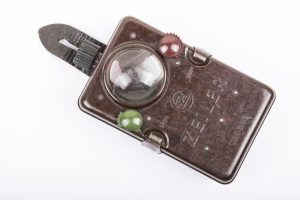
Zeiler 4640 flashlight
Nice original bakelite Zeiler 4640 flashlight.
-
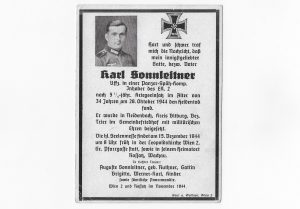
Westfront death card Panzer-Späh-Kompanie
Death card of Karl Sonnleitner, Unteroffizier in a Panzer Späh (Reconnaissance) Kompanie. Karl was awarded the EK2. He was killed 28.10.1944 and is buried in Bitburg-Kolmeshöhe.
-
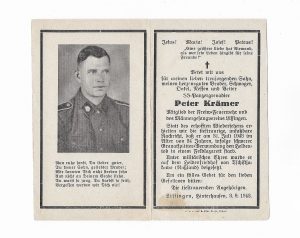
Eastern front death card SS-Panzergrenadier Totenkopf
Death card of SS-Panzergrenadier Peter Krämer in the division Totenkopf. Killed in action in Tschistjakowo. Krämer was 34 years old and was killed 31.7.1943 by wounds by heavy shrapnel wounds. He was buried in Tschistjakowo.
-

Dutch: A Guide to the Spoken Language TM 30-307
Neat little US manual on the Dutch spoken language. Printed and handed out to the US troops before they crossed the Dutch border. Neat item for a Market Garden display!
-
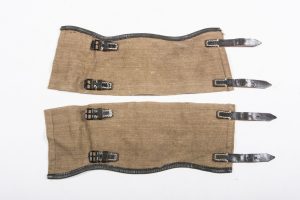
Pair of m37 pattern gaiters or Gamaschen
In very good condition nicely maker marked and dated 1942.
-
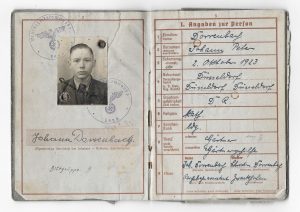
Wehrpass Johann Dorrenbach, Aufklärungsabteilung 116 – Der Windhund
Wehrpass to Schütze Johann Dorrenbach member of Aufklärungsabteilung 116 part of the 116. Panzerdivision Der Windhund. Dorrenbach was awarded the Verwundeten Abzeichen im Schwarz in 1943 with 4. Kompanie Panzer Aufklärungsabteilung 116. He was awarded the Nahkampfspange 1. Stüfe and Algemeines Stürmabzeichen on 12.1.1944 post mortem. He was killed in action 22.9.1943 at Brückenkopf Saporoshe, Lukaschewo, Ukraine and his remains where never found. Wehrpass to a highly decorated Frontkämpfer of the famous 116. Panzerdivision ‘Der Windhund’!
-

Soldbuch Kampfgruppe Bahr, Divisions Gruppe Von Hake – Berlin, Elbe 1945
Late war Soldbuch of Jäger Hildebrandt. The soldbuch was handed out on the 1st of April 1945. At this time Jäger Hildebrandt served in the Genesenden-Kompanie-Grenadier Ersatz und Ausbildungs battalion 467, with was located in Stendal near the Elbe river. He was awarded the Verwundetenabzeichen im Schwarz and Kriegsverdienstkreuz II Klasse mit Schwerter on Hitlers birthday in 1945. Very hard to find late war Soldbuch for a Berlin battle veteran!
With the Soviet and Allied forces advancing towards Berlin, Jäger Hildebrandt was transferred to Kampfgruppe Oberstleutnant Bahr, which was part of the Divisionsgruppe Von Hake as Grenadier-Regiment Von Hake. A hastily formed unit which fell subordinate to the XXXXI Panzerkorps. The Kampfgruppe Bahr/Grenadier regiment von Hake was made up from several units like a Flak battalion from Hannover, Gren.E.A.Btl. 467 from Stendal and a battalion of the Hundeschule Rathenow. On the 22nd of April the Panzerkorps fell under the leadership of the 12th Army, commanded by General der Panzertruppe Walter Wenck, and was sent east of the Elbe river to attack towards Berlin, and relieve the units trapped in and around the city. The main effort of the 12th army was to attack towards Potsdam and the trapped 9th Army at Halbe. Initially the attack surprised the Russians and the German forces gained some success, reaching as far as Schwielowsee near Potsdam. The Divisionsgruppe Von Hake however was sent further north to the area of Neuruppin and northwest of Havelberg to face the Russian 47th Army. An attack by the XXXXI Panzerkorps which was intended to push towards the city of Berlin didn’t stand any chance, instead they broke through at Kyritz on the 1.5.1945, on 2.5.1945 another Soviet attack broke trough the Panzerkops lines at Friesack and Fehrbellin. What was left of the Divisionsgruppe von Hake tried to withdraw to the bridgehead at Tangermünde and thus escape Russian captivity.
-

German issue mosquito net or Mückennetz
A very nice wartime mosquito net in good condition. It is nicely made in the typical textbook light green colour and large enough to fit over a helmet.
-

Tropical Heer belt buckle Gustav Brehmer 1940
A very nice example of a tropical Heer belt buckle by Gustav Brehmer as intended for wear with members of the Afrikakorps. Marked and dated under the prongs GB 40surely the earliest tropical belt buckle I have seen!
-
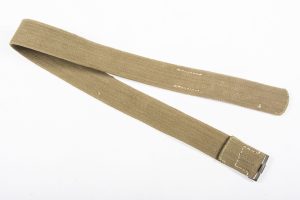
Tropical equipment belt size 95
A perfect tropical belt in mint condition. The size is 95 cm which is a perfect mannequin size. The belt is minty and impossible to upgrade.
-
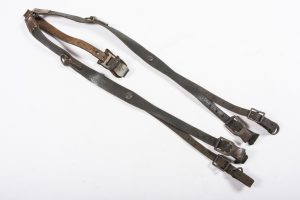
Heer Cavalry Y-straps
Rare pair of period converted lightweight Y-straps for Cavalry use. This model was issued to cavalry troops from 1940 onwards. They are of the same design as the lightweight model as used by the Luftwaffe and Kriegsmarine but feature auxiliary side straps with D-rings and two vertical D-rings on the back. These small changes where made so the saddle bag can be worn on the back. Rare cavalry Y-strap!
-
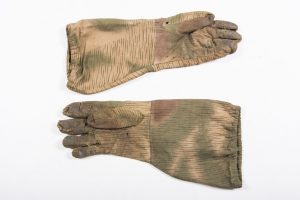
Heer/Luftwaffe Sumpftarn sniper gloves
A fantastic pair of Sumpftarn sniper gloves in combat worn condition. I’ve seen many mint examples but this is the only ever pair I’ve seen in obviously field used condition. These gloves show loads of patina and are perfect for a combat mannequin. You can find a mint pair – but you’ll be looking for years if you want a nice used pair like this.
-
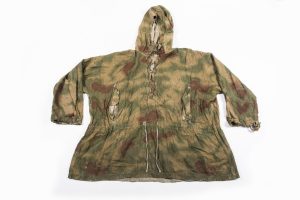
Heer/Luftwaffe hooded ’43 Sumpftarn sniper smock
Nice original ’43 Sumpftarn sniper smock. Late war smock designed for wear and use by Scharfschützen in all branches of the Wehrmacht. The smock is in good worn condition and has a number of small holes and one large repair which are typical for a thin garment worn in densely wooded areas. The smock is a nice size fitting most if not all mannequins. The smock is complete with both of its drawstrings and has shortened sleeves. A very nice surely combat worn smock with strong and vibrant colours which would be very hard to upgrade for a combat mannequin!
-
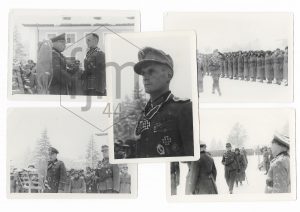
Unique photographs Knights Cross ceremony Oberfeldwebel Friedrich Hengstler 3./Geb.J.Rgt. 98
Unique photo set of the Knights Cross ceremony of Oberfeldwebel Friedrich Hengstler on 12.9.1941. Hengstler served as Zugführer in 3. Kompanie Gebirgsjäger Regiment 98 and was awarded the Knights Cross by General der Artillerie Edmund Wachenfeld because took over the leadership of his company during the most dangerous attack of enemy forces. Despite being heavily wounded he managed to stop the Soviet advance, had his unit counterattack the enemy and secured the left flank of his battaillon. This is his personal set off pictures of the award ceremony. These pictures are unique!
-
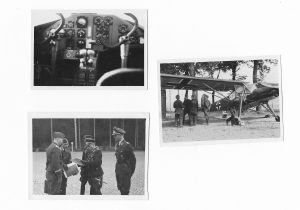
Set of pictures of Fieseler Storch Von Schlippenbach KG200
A nice set of pictures of a Fieseler Storch and a group of officers of Kampfgeschwader 200. One of them is named Von Schlippenbach.
-

Late war Heer rucksack in blue canvas marked 0/0125/0035
A late war, blue rucksack intended to be worn on the Y-straps. This rucksack is in mint condition and would be a very nice addition to any equipment collection. The rucksack is nicely marked 0/0125/0035 on the reverse. The brown and black leather is in good supple condition.
-

Early M31 Heer Splittertarn Zeltbahn named Herzebrock
Stunning named M31 Heer Zeltbahn in very good condition. Nicely named DAK Herzebrock. This is the first one I’ve seen named like this. A very nice example!
-
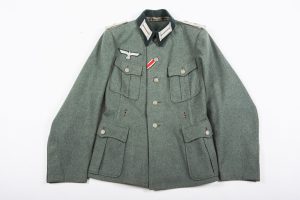
Stunning converted EM M34 field blouse for a Leutnant in 5./IR.111 Holland/Belgium/France
Stunning untouched Heer M34 tunic with full wartime sewn insignia for a Leutnant der Infanterie Regiment 111 – 35. Infanteriedivision. The garment is in very good condition retaining most if not all of the nap in the wool. The garment is a period converted EM tunic which most probably makes this a field tunic. The M34 model can be recognized with the open back and the the waist ties. The garment is nicely unit marked to Infanterie Regiment 111 inside the garment – matching with the shoulder boards. The garment is a perfect garment for a 1940 display sporting shoulder boards and markings for Infanterie Regiment 111 – a unit which fought hard in the 1940 campaign in the south of the Netherlands. Very hard to find a historic tunic like this, it would be a very nice base for a combat mannequin! Please find below a short description of the 1940 battles and places where this tunic most probably went in 1940.
On May 10 1940, at 05:35 hours IR 111 via Merkstein – Herzogenrath – Noppenberg – Wilhelm Schacht – Grube Nordstern ahead crossed the Dutch border. The border fortifications at Kerkrade, Heerlen and Valkenburg were broken against light resistance only. At 06:10 Kerkrade was in German hands and the railways facilities there were taken without damages. Both advance guards proceeded forwards. At 09:15 hours the first great obstacle, the Juliana Canal, was reached but all the bridges were already blown there. At 11:00 hours with strong artillery support, both frontline regiments got across it. Leaving Maastricht and Lanaeken behind the IR 111 reached the Petersheimer wood’s easthern edge with its frontline battalions. The wood was free of enemies so several recce patrols were sent towards the Albert Canal. By midnight both infantry regiments (IR 111 and IR 34) were deployed along it. On May 11 1940, during afternoon hours and after hard fighting, the division’s troops could get across the Albert Canal; hence within 48 hours the 35 ID had overcame all the water’s obstacles (four) laying ahead its march routes and the first attack’s objective, the road Bilsen – Maartenslinde, was reached.
The whole day the enemy carried out aerial raids, british, french and belgian planes, all of them were rejected by our own Flak (antiaircraft guns). This fact delayed the heavy guns’ advance hampering its march towards the front. On May 12 1940, the motorized elements resumed its march at 05:00 hours getting across the Juliana Canal, the Meuse and the Meuse Canal.
Along the road they found also the infantry columns and its vehicles, up to 2/3 of them were composed of belgian and dutch cars, besides there were little charts and horses also. The “landsers” carried their machineguns, ammunitions boxes and assault tools even in baby carriages. Speaking on their mood and discipline, they marched with unfasten collars and rolled up sleeves, looking for any relief for the burning sun and the dust.
The night from 14 to 15 may 1940 went quietly; on May 15 1940 at 09:00 hours one panzer division (3 Pz) supported by one aerial corps launched an assault against the Dyle position (Dylestellung). The sky was full of stukas, Do-17 and fighters. Around nightfall came the orders for the next day.
On May 16 1940, the movement proceeded with the Dyle crossing. At 08:00 hours resumed its march having the task of covering the division’s right flank. At 11:00 hours St. martin was reached without enemy actions. After leaving behind the Dyle’s battlefield the detachment reached Baissy-Thy. Tank alarm!. Three enemy tanks were put out of action by antitanks cannons but one of the crews was either killed or wounded in turn; one of the light armored vehicle (panzerspähwagen) caught fire also.
The recce patrols sent ahead reported around 60 tanks patrolling on the road to Nivelles and they stood there (Banterlez) in the evening. Meanwhile as the IR 111 was approaching Chastre could see the French troops’ withdrawal so according division’s orders strong recce patrols were sent against Ferme del Croix and Ferme Sartage; the IR 34 followed near the IR 111.
On may 20 1940, the mission was to move forward to the river Escaut in order to established a bridgehead at Antoing – Tournai. The AA 35 had reached the river by Ramecroix. In that town the Germans could see a destroyed English column, parts of vehicles mixed with human remains were littered all over the ground. The Detachment got heavy artillery fire and should retreat towards Pipaix.
That very day the Schelde crossing began; it was the hardest day of the whole the campaign. The IR 109 crossed by Antoing and the IR 111 did the same by Peronnes; both frontline battalions could establish two little bridgeheads against English elite troops. Due to strong counterattacks, supported by tanks and artillery fire, the bridgeheads were lost; nevertheless, the IR 109 could maintain one little strong hold on the far river bank.
On May 21 1940, the AA remained at Pipaix while the IR 111 could get across the river Escaut establishing a bridgehead. The Division took up defensive positions and also stood fast next day (22 May).
On May 23 1940, the order to carry out the reconnaissance towards Fontenay. As a result, it was known that the enemy had already retreated from the water line leaving its positions behind. A serviceable shuttle was found at Fontenay. The large grey columns proceeded slowly ahead. That very afternoon, the 35 ID had reached the French-Belgian border line.
On May 24 1940, at 06:00 hours the unit proceeded its march to Antoing, where the Abteilung crossed the Escaut. The British troops followed its withdrawal through Tournai heading to Templeuves. At every village and crossroads, the Germans found obstacles and blocking positions.
On May 25 1940, the cyclist squadron (radfahr-schwadron) relieved the infantry and by dawn that infantry regiment had proceeded its march as a whole. A hard task: to ward a two kilometer frontline, in its front Scottish troops. The officers were uneasy, however the day went quite calm, in spite of during the night there were alarms and own artillery fire.
On May 26 1940, at dawn antitank alarm; a Recce Patrol of five men was detached to deal with, but in reaching the spot, reported it was an old out of service truck. At noon and evening, heavy aerial attacks against Lille and Roubaix. Around 22:00 the 253 ID came serving as replacements.
A stunning untouched Heer Infanterie Leutnant in Infanterie Regiment 111 field blouse that would incredibly hard to upgrade!
-
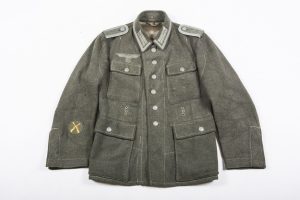
Textbook M43 Heer Infanterie Unteroffizier combat tunic
Textbook original Heer M43 combat tunic for a Unteroffizier der Infanterie. The tunic retains fully machine sewn insignia and a set of period applied award loops. The garment is in good, used condition and is named inside the rayon lining at the hight of the collar. The garment comes with a very nice and hard to find pair of shoulderstraps for a Unteroffizier der Infanterie in very good condition with matching subdued(!) tresse.
-
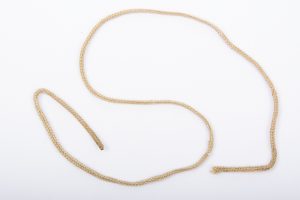
German helmet liner drawstring
Hard to find spare in good used condition. Often missing from many helmets, this is a perfect addition to a helmet with some patina.
-
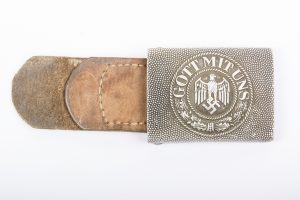
Tabbed aluminum Heer belt buckle marked R. Sieper & Sohne
A nice aluminum Heer belt buckle marked R. Sieper & Sohne Lüdenscheid 1939. Hard to find in good condition with most of the original paint remaining!
Showing 10981–11040 of 14048 results


